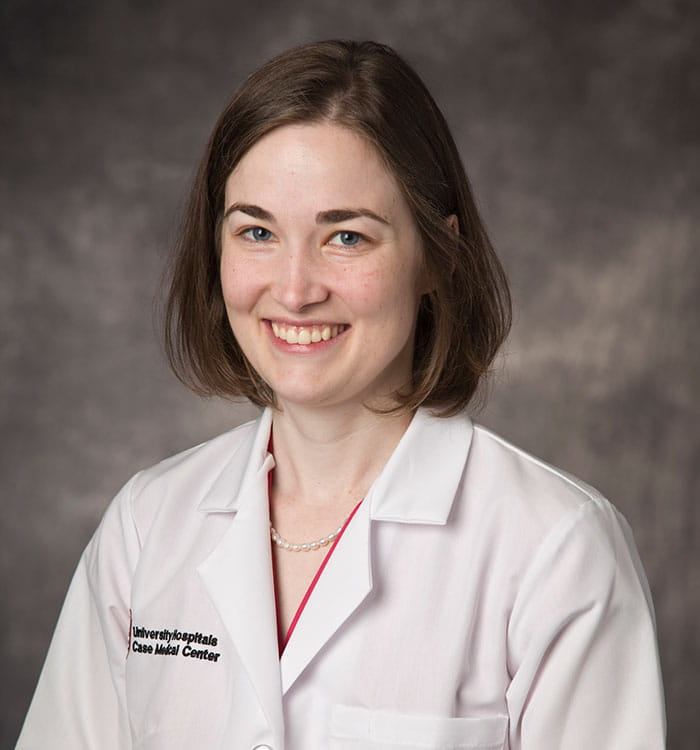UH Rainbow Provides Continuing Leadership on Neonatal Abstinence Syndrome
February 03, 2021

Work on statewide quality improvement collaborative leads to further decreases in length of stay for infants exposed to opioids in utero
Innovations in Pediatrics | Winter 2021
Members of the Ohio Perinatal Quality Collaborative (OPQC), including neonatologists from UH Rainbow Babies & Children’s Hospital, have been working to improve outcomes for Ohio infants exposed to opiates in utero since 2014, with much to show for it in terms of improvements in length of hospital stay.
 Moira Crowley, MD
Moira Crowley, MD“What we were trying to do is standardize the care of these infants -- standardize our non-pharmacologic bundle of care and our pharmacologic bundle of care,” says UH Rainbow neonatologist Moira Crowley, MD, who is also Associate Professor of Pediatrics at Case Western Reserve University School of Medicine. “The first part of the project was standardizing the pharmacologic bundle. And we have actually done a really good job with that. We were able to decrease our length of stay across the state."
Not content with that, however, the group has turned its attention to non-pharmacologic measures aimed at improving care for infants with neonatal abstinence syndrome (NAS). Specifically, they’ve addressed the question of which type of formula is the best choice for these infants – low-lactose formula (LLF) or high-calorie formula (HCF). (Although the Ohio Perinatal Quality Collaborative recommends breastfeeding for the mothers of NAS infants, not all mothers are able to make that choice.)
“Throughout the initial quality improvement effort, there was an increase in overall compliance with the non-pharmacologic bundle, but significant variation in LLF and HCF use remained, with 60% of infants receiving LLF and 20% receiving HCF,” Dr. Crowley says. “Also, a survey of OPQC teams after the initial project revealed continued uncertainty regarding the use of LLF and HCF as a part of non-pharmacologic support. People said the measure they felt least confident about was choice of formula. So we said, with our larger group, let’s look at this in a quality improvement, scientific way to see if we could see if LLF or HCF did help improve the, care of infants with neonatal abstinence syndrome.”
To get the answers they needed, Dr. Crowley and her OPQC colleagues asked NICUs across the state to report their current practices with regard to formula for NAS infants. They then tracked the type of formula used against length of stay for NAS infants through a process of orchestrated testing (OT).
Results show that 47 sites caring for 546 NAS infants self-selected into the four OT formula groups, with the two variables of lactose level and calorie content. The benefit of HCF for NAS infants was seen in terms of reducing weight loss, preventing treatment failure and reducing length of stay.
“We found that the higher calorie formula was indeed beneficial for those infants who were opiate-exposed and could not breastfeed,” Dr. Crowley says.
Given these results, the OPQC updated its non-pharmacologic treatment bundle to recommend HCF when breastfeeding was not possible. During implementation of this change, HCF use increased, and length of stay deceased for NAS infants from 17.1 to 16.4 days across the OPQC.
“Once we started seeing that the high calorie formula definitely seemed to improve length of stay, then we recommended that all the sites use 22 calorie formula,” Dr. Crowley says. “When sites adopted that as well, we saw the decrease in length of stay across the collaborative.”
For Dr. Crowley, this project highlights the advantages of having a standardized approach and a “not good enough” mindset when it comes to quality improvement.
“Having a standardized approach also is very helpful,” she says. “Even in the original work we did with six Ohio children’s hospitals before OPQC, what we found was standardizing your protocol actually improved outcomes as well.”
She says she hopes this work will be helpful to others who are caring for these most vulnerable of patients – and will provide them with practical guidance they can use.
”There's been a lot published about the benefits of breastfeeding when it's appropriate, and by far that is our first recommendation for NAS infants,” she says. “But with what we've found, when breastfeeding is not an option, then you should consider using a higher calorie formula.”


